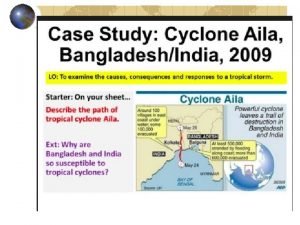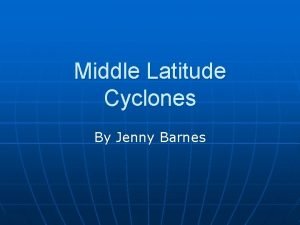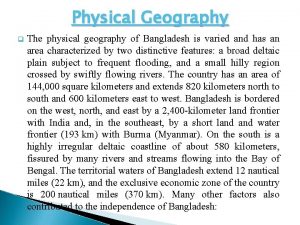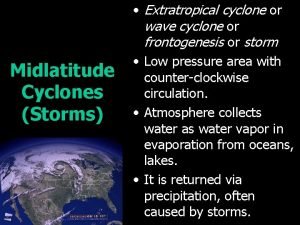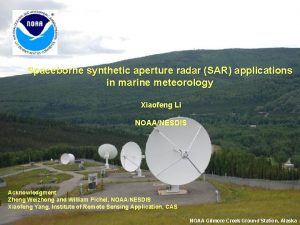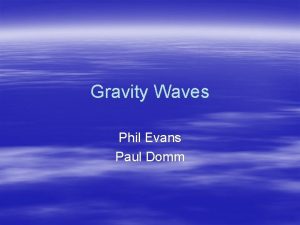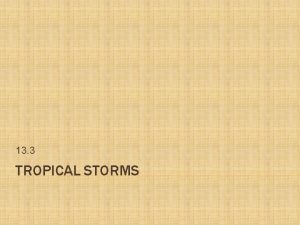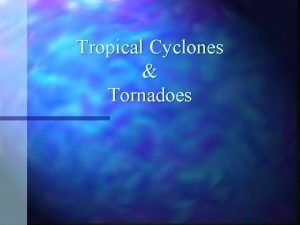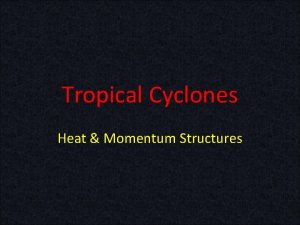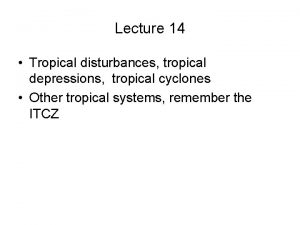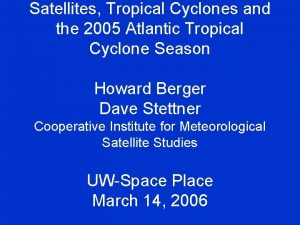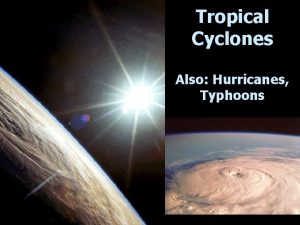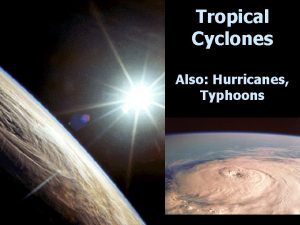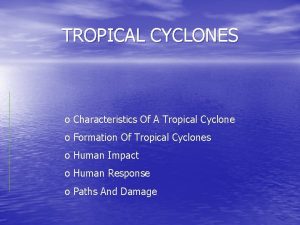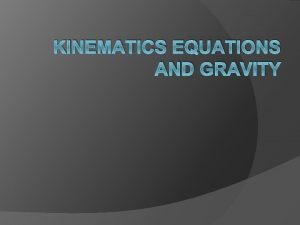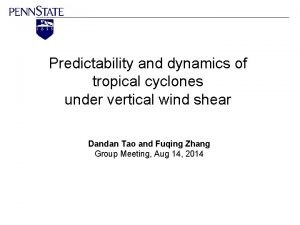Tropical dynamics and Tropical cyclones 1 Gravity waves

























- Slides: 25

Tropical dynamics and Tropical cyclones 1. . Gravity waves 2. Small scale Kelvin wave

3. Large-scale Kelvin wave In a rotating frame, large-scale kelvin wave must be: a. a boundary wave. b. propagating with the boundary on its right in the North. hemisphere. c. a trapped wave decaying from the boundary. 4. Equatorial Kelvin wave P North C X P C X South

4. El Niño and La Niña El Niño is characterized by unusually warm ocean temperatures in the Equatorial Pacific, as opposed to La Niña, which characterized by unusually cold ocean temperatures in the Equatorial Pacific. El Niño is an oscillation of the ocean-atmosphere system in the tropical Pacific having important consequences for weather and climate around the globe. 2011 El Niño


5. Walker circulation

6. Delayer oscillator theory Eastern Pacific Western Pacific warm cold El Niño year Thermocline Normal year Rossby wave upwelling downwelling Equator upwelling downwelling Kelvin wave Rossby wave upwelling thermocline


Vertical temperature anomalies along the equator during 1997 -1998 El Niño event. February 1997 160 W 80 W January 1998

8. Southern Oscillation Darwin Tahiti 1958 -1998 Sea level pressure anomaly at Tahiti and Darwin

Southern Oscillation Index (SOI): defined as the pressure difference between Tahiti in the southeast Pacific and Darwin in the western Pacific. Negative SOI corresponds to El nino Positive SOI corresponds to La nina. (ENSO)

Impact of ENSO on Global Climate Rainfall anomaly during 1997 -1998 El nino East Europe East China California Florida India Indonesia Southern East Africa Northern Australia Amazon Uruguay Why an anomaly, such as ENSO in the equatorial region, can affect climate thousand miles away in mid and high latitude?

Teleconnections

1. Where does a hurricane come from? Africa (easterly) jet Very strong temperature gradient Dynamic Instability Barotropic Instability Thermal wind Easterly (tropical) wave


2. How can a hurricane maintain its strength? Pressure grad. force Centrifugal force Secondary circulation Pressure grad. force Centrifugal force Frictional force Inflow Pressure grad. Centrifugal force Boundary layer Ekman pumping

Hurricane Vortex Coriolis force Centrifugal force Diverging Spin down Pressure grad. force L Converging Buoyancy Spin up X Ekman Pumping Boundary Layer It is the convective clouds that generate spin up process to overcome the spin down process induced by the Ekman pumping

Where do energy and moisture come from to foster a large amount of convection in a hurricane? Warm ocean What process is responsible for bringing the energy and moisture taken from the ocean surface to the atmosphere? Boundary layer turbulent transport process

3. What determines the movement of a hurricane?

4. Why we cannot accurately predict the track of a hurricane sometimes? Where the storm is heading to? ? Sensitive dependence on initial conditions, butterfly effect

How to improve hurricane forecasting? Ensemble forecasting

Issues with numerical forecasts Newton’s law of motion governs hurricane movement. Initial value problem q. British scientist L. F. Richardson q. American meteorologist J. G. Charney Weather Prediction by Quasi-geostrophic model, 1950 Numerical Process, 1922 What causes the failure of Richardson’s numerical simulation?

q In the 50 s, people are optimistic about numerical weather forecast due to: v Global observational network of the atmosphere has been established, which can provide more accurate initial fields. v Great success of numerical calculation in other fields, such as calculating the trajectories of planetary orbits and long-range missals. q. The accuracy of numerical forecast improved dramatically during the 60 s, 70 s, and 80 s. q. But unfortunately, improvement slowed nearly to a standstill beginning around 90 s. Why?

Sub-grid scale (SGS) processes Scale (km) 1800 18 1. 8 0. 18 0. 018 Van de Hoven (1957) 10 – 100 km


 Global distribution of tropical storms
Global distribution of tropical storms Gravity for dummies and dummies for gravity equations
Gravity for dummies and dummies for gravity equations Compare and contrast p waves and s waves using venn diagram
Compare and contrast p waves and s waves using venn diagram What are middle latitude cyclones
What are middle latitude cyclones Geography of bangladesh
Geography of bangladesh Mid latitude cyclone characteristics
Mid latitude cyclone characteristics Air masses and fronts
Air masses and fronts Differences between mechanical and electromagnetic waves
Differences between mechanical and electromagnetic waves Example of a mechanical wave
Example of a mechanical wave How are rainbows made
How are rainbows made Short wave vs long wave radiation
Short wave vs long wave radiation Mechanical waves and electromagnetic waves similarities
Mechanical waves and electromagnetic waves similarities Mechanical waves and electromagnetic waves similarities
Mechanical waves and electromagnetic waves similarities Surface waves and body waves
Surface waves and body waves Mechanical waves vs electromagnetic waves venn diagram
Mechanical waves vs electromagnetic waves venn diagram Difference between constructive and destructive waves
Difference between constructive and destructive waves Atmospheric gravity waves
Atmospheric gravity waves Forceparcel
Forceparcel Electromagnetic waves are transverse waves true or false
Electromagnetic waves are transverse waves true or false The wave chapter 13
The wave chapter 13 Sound is a longitudinal wave
Sound is a longitudinal wave Electromagnetic waves vs mechanical waves
Electromagnetic waves vs mechanical waves Is a seismic wave mechanical or electromagnetic
Is a seismic wave mechanical or electromagnetic Whats a transverse wave
Whats a transverse wave Compare and contrast transverse and longitudinal waves
Compare and contrast transverse and longitudinal waves Gravity and friction
Gravity and friction
